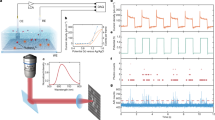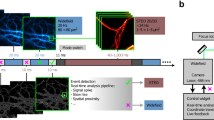Abstract
The ability to sense and respond to the environment is a hallmark of living systems. These processes occur at the levels of the organism, cells and individual molecules. Sensing of extracellular changes could result in a structural or chemical alteration in a molecule, which could in turn trigger a cascade of intracellular signals or regulated trafficking of molecules at the cell surface. These and other such processes allow cells to sense and respond to environmental changes. Often, these changes and the responses to them are spatially and/or temporally localized, and visualization of such events necessitates the use of high-resolution imaging approaches. Here we discuss optical imaging approaches and tools for imaging individual events at the cell surface with improved speed and resolution.
This is a preview of subscription content, access via your institution
Access options
Subscribe to this journal
Receive 12 print issues and online access
$259.00 per year
only $21.58 per issue
Buy this article
- Purchase on Springer Link
- Instant access to full article PDF
Prices may be subject to local taxes which are calculated during checkout




Similar content being viewed by others
References
Neher, E. & Sakmann, B. Single-channel currents recorded from membrane of denervated frog muscle fibres. Nature 260, 799–802 (1976).
Sakmann, B. & Neher, E. Patch clamp techniques for studying ionic channels in excitable membranes. Annu. Rev. Physiol. 46, 455–472 (1984).
Sakmann, B. Elementary steps in synaptic transmission revealed by currents through single ion channels. Science 256, 503–512 (1992).
Angleson, J.K. & Betz, W.J. Monitoring secretion in real time: capacitance, amperometry and fluorescence compared. Trends Neurosci. 20, 281–287 (1997).
Mosharov, E.V. & Sulzer, D. Analysis of exocytotic events recorded by amperometry. Nat. Methods 2, 651–658 (2005).
Ruta, V., Chen, J. & MacKinnon, R. Calibrated measurement of gating-charge arginine displacement in the KvAP voltage-dependent K+ channel. Cell 123, 463–475 (2005).
White, S.H., Ladokhin, A.S., Jayasinghe, S. & Hristova, K. How membranes shape protein structure. J. Biol. Chem. 276, 32395–32398 (2001).
Gandhavadi, M., Allende, D., Vidal, A., Simon, S.A. & McIntosh, T.J. Structure, composition, and peptide binding properties of detergent soluble bilayers and detergent resistant rafts. Biophys. J. 82, 1469–1482 (2002).
Sekar, R.B. & Periasamy, A. Fluorescence resonance energy transfer (FRET) microscopy imaging of live cell protein localizations. J. Cell Biol. 160, 629–633 (2003).
Rust, M., Bates, M. & Zhuang, X. Sub-diffraction-limit imaging by stochastic optical reconstruction microscopy (STORM). Nat. Methods 3, 793–795 (2006).
Denk, W., Strickler, J.H. & Webb, W.W. Two-photon laser scanning fluorescence microscopy. Science 248, 73–76 (1990).
Takahashi, N., Kishimoto, T., Nemoto, T., Kadowaki, T. & Kasai, H. Fusion pore dynamics and insulin granule exocytosis in the pancreatic islet. Science 297, 1349–1352 (2002).
Webb, W.W. Applications of fluorescence correlation spectroscopy. Q. Rev. Biophys. 9, 49–68 (1976).
Fahey, P.F. et al. Lateral diffusion in planar lipid bilayers. Science 195, 305–306 (1977).
Schwille, P., Korlach, J. & Webb, W.W. Fluorescence correlation spectroscopy with single-molecule sensitivity on cell and model membranes. Cytometry 36, 176–182 (1999).
Axelrod, D. Total internal reflection fluorescence microscopy in cell biology. Traffic 2, 764–774 (2001).
Axelrod, D. Cell-substrate contacts illuminated by total internal reflection fluorescence. J. Cell Biol. 89, 141–145 (1981).
Axelrod, D., Burghardt, T.P. & Thompson, N.L. Total internal reflection fluorescence. Annu. Rev. Biophys. Bioeng. 13, 247–268 (1984).
Kawano, Y. et al. High-numerical-aperture objective lenses and optical system improved objective type total internal reflection fluorescence microscopy. Proc. SPIE 4098, 142–151 (2000).
Axelrod, D. Selective imaging of surface fluorescence with very high aperture microscope objectives. J. Biomed. Opt. 6, 6–13 (2001).
Schneckenburger, H. Total internal reflection fluorescence microscopy: technical innovations and novel applications. Curr. Opin. Biotechnol. 16, 13–18 (2005).
Kittel, R.J. et al. Bruchpilot promotes active zone assembly, Ca2+ channel clustering, and vesicle release. Science 312, 1051–1054 (2006).
Willig, K.I., Rizzoli, S.O., Westphal, V., Jahn, R. & Hell, S.W. STED microscopy reveals that synaptotagmin remains clustered after synaptic vesicle exocytosis. Nature 440, 935–939 (2006).
Sieber, J.J., Willig, K.I., Heintzmann, R., Hell, S.W. & Lang, T. The SNARE motif is essential for the formation of syntaxin clusters in the plasma membrane. Biophys. J. 90, 2843–2851 (2006).
Shaner, N.C., Steinbach, P.A. & Tsien, R.Y. A guide to choosing fluorescent proteins. Nat. Methods 2, 905–909 (2005).
Giepmans, B.N., Adams, S.R., Ellisman, M.H. & Tsien, R.Y. The fluorescent toolbox for assessing protein location and function. Science 312, 217–224 (2006).
Tsien, R.Y. The green fluorescent protein. Annu. Rev. Biochem. 67, 509–544 (1998).
Griesbeck, O. Fluorescent proteins as sensors for cellular functions. Curr. Opin. Neurobiol. 14, 636–641 (2004).
Lippincott-Schwartz, J. & Smith, C.L. Insights into secretory and endocytic membrane traffic using green fluorescent protein chimeras. Curr. Opin. Neurobiol. 7, 631–639 (1997).
Lukyanov, K.A., Chudakov, D.M., Lukyanov, S. & Verkhusha, V.V. Innovation: photoactivatable fluorescent proteins. Nat. Rev. Mol. Cell Biol. 6, 885–891 (2005).
Lippincott-Schwartz, J., Altan-Bonnet, N. & Patterson, G.H. Photobleaching and photoactivation: following protein dynamics in living cells. Nat. Cell Biol. Suppl, S7–S14 (2003).
Chudakov, D.M. & Lukyanov, K.A. Use of green fluorescent protein (GFP) and its homologs for in vivo protein motility studies. Biochemistry (Mosc.) 68, 952–957 (2003).
Hofmann, M., Eggeling, C., Jakobs, S. & Hell, S.W. Breaking the diffraction barrier in fluorescence microscopy at low light intensities by using reversibly photoswitchable proteins. Proc. Natl. Acad. Sci. USA 102, 17565–17569 (2005).
Betzig, et al. Imaging intracellular fluorescent proteins at nanometer resolution. Science 313, 1642–1645 (2006).
Jaiswal, J.K., Goldman, E.R., Mattoussi, H. & Simon, S.M. Use of quantum dots for live cell imaging. Nat. Methods 1, 73–78 (2004).
Jaiswal, J.K. & Simon, S.M. Potentials and pitfalls of fluorescent quantum dots for biological imaging. Trends Cell Biol. 14, 497–504 (2004).
Gao, X. et al. In vivo molecular and cellular imaging with quantum dots. Curr. Opin. Biotechnol. 16, 63–72 (2005).
Michalet, X. et al. Quantum dots for live cells, in vivo imaging, and diagnostics. Science 307, 538–544 (2005).
Uyeda, H.T., Medintz, I.L., Jaiswal, J.K., Simon, S.M. & Mattoussi, H. Synthesis of compact multidentate ligands to prepare stable hydrophilic quantum dot fluorophores. J. Am. Chem. Soc. 127, 3870–3878 (2005).
An, S. & Zenisek, D. Regulation of exocytosis in neurons and neuroendocrine cells. Curr. Opin. Neurobiol. 14, 522–530 (2004).
Palfrey, H.C. & Artalejo, C.R. Secretion: kiss and run caught on film. Curr. Biol. 13, R397–R399 (2003).
Jaiswal, J.K., Chakrabarti, S., Andrews, N.W. & Simon, S.M. Synaptotagmin VII restricts fusion pore expansion during lysosomal exocytosis. PLoS Biol. 2, E233 (2004).
Rink, J., Ghigo, E., Kalaidzidis, Y. & Zerial, M. Rab conversion as a mechanism of progression from early to late endosomes. Cell 122, 735–749 (2005).
Lampson, M.A., Schmoranzer, J., Zeigerer, A., Simon, S.M. & McGraw, T.E. Insulin-regulated release from the endosomal recycling compartment is regulated by budding of specialized vesicles. Mol. Biol. Cell 12, 3489–3501 (2001).
Oheim, M., Loerke, D., Stuhmer, W. & Chow, R.H. The last few milliseconds in the life of a secretory granule. Docking, dynamics and fusion visualized by total internal reflection fluorescence microscopy (TIRFM). Eur. Biophys. J. 27, 83–98 (1998).
Steyer, J.A., Horstmann, H. & Almers, W. Transport, docking and exocytosis of single secretory granules in live chromaffin cells. Nature 388, 474–478 (1997).
Kreitzer, G. et al. Three-dimensional analysis of post-Golgi carrier exocytosis in epithelial cells. Nat. Cell Biol. 5, 126–136 (2003).
Ma, L. et al. Direct imaging shows that insulin granule exocytosis occurs by complete vesicle fusion. Proc. Natl. Acad. Sci. USA 101, 9266–9271 (2004).
Ehrlich, M. et al. Endocytosis by random initiation and stabilization of clathrin-coated pits. Cell 118, 591–605 (2004).
Ohara-Imaizumi, M. et al. Monitoring of exocytosis and endocytosis of insulin secretory granules in the pancreatic beta-cell line MIN6 using pH-sensitive green fluorescent protein (pHluorin) and confocal laser microscopy. Biochem. J. 363, 73–80 (2002).
O'Connell, K.M. & Tamkun, M.M. Targeting of voltage-gated potassium channel isoforms to distinct cell surface microdomains. J. Cell Sci. 118, 2155–2166 (2005).
Massol, R.H., Larsen, J.E. & Kirchhausen, T. Possible role of deep tubular invaginations of the plasma membrane in MHC-I trafficking. Exp. Cell Res. 306, 142–149 (2005).
Lidke, D.S., Lidke, K.A., Rieger, B., Jovin, T.M. & Arndt-Jovin, D.J. Reaching out for signals: filopodia sense EGF and respond by directed retrograde transport of activated receptors. J. Cell Biol. 170, 619–626 (2005).
Warshaw, D.M. et al. Differential labeling of myosin V heads with quantum dots allows direct visualization of hand-over-hand processivity. Biophys. J. 88, L30–L32 (2005).
Dahan, M. et al. Diffusion dynamics of glycine receptors revealed by single-quantum dot tracking. Science 302, 442–445 (2003).
Courty, S., Luccardini, C., Bellaiche, Y., Cappello, G. & Dahan, M. Tracking individual kinesin motors in living cells using single quantum-dot imaging. Nano Lett. 6, 1491–1495 (2006).
Pramanik, A. & Rigler, R. Ligand-receptor interactions in the membrane of cultured cells monitored by fluorescence correlation spectroscopy. Biol. Chem. 382, 371–378 (2001).
Lieto, A.M., Cush, R.C. & Thompson, N.L. Ligand-receptor kinetics measured by total internal reflection with fluorescence correlation spectroscopy. Biophys. J. 85, 3294–3302 (2003).
Bacia, K., Scherfeld, D., Kahya, N. & Schwille, P. Fluorescence correlation spectroscopy relates rafts in model and native membranes. Biophys. J. 87, 1034–1043 (2004).
Ohsugi, Y., Saito, K., Tamura, M. & Kinjo, M. Lateral mobility of membrane-binding proteins in living cells measured by total internal reflection fluorescence correlation spectroscopy. Biophys. J. 91, 3456–3464 (2006).
Gustafsson, M.G. Extended resolution fluorescence microscopy. Curr. Opin. Struct. Biol. 9, 627–634 (1999).
Jaiswal, J.K., Andrews, N.W. & Simon, S.M. Membrane proximal lysosomes are the major vesicles responsible for calcium-dependent exocytosis in nonsecretory cells. J. Cell Biol. 159, 625–635 (2002).
Schmoranzer, J., Goulian, M., Axelrod, D. & Simon, S.M. Imaging constitutive exocytosis with total internal reflection fluorescence microscopy. J. Cell Biol. 149, 23–32 (2000).
Johns, L.M., Levitan, E.S., Shelden, E.A., Holz, R.W. & Axelrod, D. Restriction of secretory granule motion near the plasma membrane of chromaffin cells. J. Cell Biol. 153, 177–190 (2001).
Allersma, M.W., Bittner, M.A., Axelrod, D. & Holz, R.W. Motion matters: secretory granule motion adjacent to the plasma membrane and exocytosis. Mol. Biol. Cell 17, 2424–2438 (2006).
Rappoport, J.Z., Taha, B.W. & Simon, S.M. Movement of plasma-membrane-associated clathrin spots along the microtubule cytoskeleton. Traffic 4, 460–467 (2003).
Merrifield, C.J., Feldman, M.E., Wan, L. & Almers, W. Imaging actin and dynamin recruitment during invagination of single clathrin-coated pits. Nat. Cell Biol. 4, 691–698 (2002).
Merrifield, C.J., Perrais, D. & Zenisek, D. Coupling between clathrin-coated-pit invagination, cortactin recruitment, and membrane scission observed in live cells. Cell 121, 593–606 (2005).
Rappoport, J.Z., Benmerah, A. & Simon, S.M. Analysis of the AP-2 adaptor complex and cargo during clathrin-mediated endocytosis. Traffic 6, 539–547 (2005).
Habuchi, S. et al. Reversible single-molecule photoswitching in the GFP-like fluorescent protein Dronpa. Proc. Natl. Acad. Sci. USA 102, 9511–9516 (2005).
Sosa, H., Peterman, E.J., Moerner, W.E. & Goldstein, L.S. ADP-induced rocking of the kinesin motor domain revealed by single-molecule fluorescence polarization microscopy. Nat. Struct. Biol. 8, 540–544 (2001).
Basche, T., Moerner, W.E., Orrit, M. & Talon, H. Photon antibunching in the fluorescence of a single dye molecule trapped in a solid. Phys. Rev. Lett. 69, 1516–1519 (1992).
Acknowledgements
Work in our laboratory is supported by grants from the National Science Foundation (NSF FEB 00520813) and the National Institutes of Health (P20 GM072015 and GM072015 to S.M.S.). We thank P. Coffino for helpful comments on the manuscript.
Author information
Authors and Affiliations
Corresponding author
Ethics declarations
Competing interests
The authors declare no competing financial interests.
Rights and permissions
About this article
Cite this article
Jaiswal, J., Simon, S. Imaging single events at the cell membrane. Nat Chem Biol 3, 92–98 (2007). https://doi.org/10.1038/nchembio855
Published:
Issue Date:
DOI: https://doi.org/10.1038/nchembio855
This article is cited by
-
Discrete LAT condensates encode antigen information from single pMHC:TCR binding events
Nature Communications (2022)
-
Injured astrocytes are repaired by Synaptotagmin XI-regulated lysosome exocytosis
Cell Death & Differentiation (2016)
-
Quantum dot-loaded monofunctionalized DNA icosahedra for single-particle tracking of endocytic pathways
Nature Nanotechnology (2016)
-
Detyrosinated Glu-tubulin is a substrate for cellular Factor XIIIA transglutaminase in differentiating osteoblasts
Amino Acids (2014)
-
Three-dimensional imaging of single nanotube molecule endocytosis on plasmonic substrates
Nature Communications (2012)



